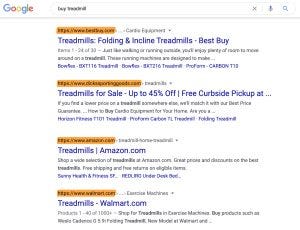Jump to Section
ToggleOur online presence can differentiate between failure and thriving in your industry. But, simultaneously, you should not try to be everything to everybody on the internet. Not everyone is your audience. You need local SEO strategies and tactics to target and reach the audience that matters most to your business. If you’ve ignored it, it’s time to change your ways.
Nearly half of all searches on Google are looking for local information. That means search inputs like “restaurants near me” or “salons in London” are a major part of online search and a starting point for many customers’ buying journeys. This proves that improving visibility through local SEO should be a priority for small businesses. You should be easily discoverable in search engines or, better still, in location-based searches.
Local SEO optimises a business website to rank higher in local search results. It’s important because it could help you attract more customers in your immediate area. However, with the increasing competition in the market and the need for local businesses to stand out from the crowd, local SEO requires more than just creating a Google Business Page and adding a few citations. In this blog post, I’ll show you seven tips for getting started with local SEO.
#1. Optimize Content for Local Keywords and Search Intent
Here’s a timeless SEO strategy. When you optimize your site content based on search intents or location-based queries, it not only becomes easily discoverable but also reflects the needs of customers searching for it. “This is what I’m looking for” will be customers’ reaction when they see your site among others in the search results or SERP. Most of all, you need to understand that there are three kinds of queries that users find on search engines and tailor your content to match these areas.
a. Navigational Search Query: This search query shows a user looking for a specific website or webpage. It happens when a user types a query like “TikTok,” “Amazon,” or “Jumia” in the search box. Because of the specificity and uniqueness involved, targeting navigation queries may be impossible if it’s not your brand. Targeting navigation queries may only work for news platforms that tell stories about a brand (Facebook, for example).
b. Informational Search Query: Informational queries include keywords like “best pizza in New York City” or “how to make pancakes from scratch.” Targeting these search queries requires high-quality SEO content that gives useful information. These are not commercial. They are often referred to as top-of-funnel content because of their informational purpose. As a local business, you can provide relevant information to your potential customers through blogs, infographics, or podcasts–all based on an SEO strategy that captures the needs of your local audience. For example, if you sell shoes online, you should be seen creating articles like the trends in fashion in 2023 or trends in the footwear e-commerce industry. Understanding informational search queries in your area can also allow you to develop new products or services that customers want and make a claim about them in your ads. For example, imagine you’re a restaurant and have found out through an SEO audit that there are queries on “sustainable cooking”. You can start incorporating eco-friendly practices in your cooking methods, make a case for them in your online marketing campaign, and add them to your local SEO strategy.
c. Transactional Search Query: As the name sounds, this query shows that the user is interested in purchasing the search. It may include a query like “Buy iPhone in Jakarta” or “iPhone 12”. Optimizing product pages for transactional search requires a careful analysis of keywords, page titles, and descriptions. Most importantly, you should add structured data to your eCommerce product pages so that Google search results can display your products clearly and attractively. Structured data is a way to make your content more easily indexed by search engines (more on it later in this article). Following trends in search intent over the years, the three types of queries mentioned here have been broken down into parts and further defined for better SEO results. You can read more about it here.

#2. Improve Your Google Business Profile (GBP, formerly Google My Business)
To improve your local ranking, Google suggests making your Business Profile “accurate, complete, and engaging” What does that mean?
a. Accurate: You have to provide as much accurate information about your business as possible. This includes things like the hours you’re open, the services and products you offer, and the location of your business (Google Maps can do this for you!).
b. Complete: Add all relevant information. A complete Google Business Profile will have a physical address, phone number, product category, product attributes, photos, and opening date/hours, website URL (if available).
c. Engaging: You have to manage and respond to customer reviews. Google provides a review link that you can share for customers to add reviews to your Business Profile. Google’s algorithm also values positive reviews. According to Google, the more reviews and positive ratings your business gets, its local ranking will be higher.
#3. Build local links
Local link building is a type of local SEO that focuses on building links from websites with high authority and relevancy to your business. The meat of the matter here is that these sites should focus on topics related to yours. The more relevant the link is, the more likely Google will be inclined to promote it on its SERPs. A good local link-building strategy can help improve your organic search rankings, increase your click-through rates and boost your business’s visibility. You can build local links through content marketing, social media outreach, or guest posting on popular blogs in your industry.
Consider the types of businesses in your local area and which ones would be interested in linking to you. For example, if you’re running a catering company, you might want to write a blog post titled “How to host a successful office party” and reach out to local restaurants offering catering services. Or maybe you sell kitchen gadgets; why not contact local food bloggers who could benefit from writing about your product?
#4. Provide Accurate Local Listings
Your business name, address, and phone are your identity, and Google only identifies with them when it’s accurate. When different versions of the same business information are posted on various websites, search engines have difficulty knowing which one is true. Leaving an outdated address, phone number, or other vital details on local directories, blogs, or social media is not a good business practice. When there’s a change in your local listing, don’t take time before you edit them. Correct errors on your business listing, if possible, by contacting the appropriate website that hosts your listing. For example, if you have incorrect information on your profile on Yahoo Local or any business directories, you should contact them about updating that information. You can also check out these local listing management tools to help you keep track of your business information online.
#5. Earn and encourage online reviews (Beyond Google Business Profile)
Reviews are one of the best ways to build trust with your customers. You must take a page out of the hospitality industry’s book or act like one if you’re in the industry. Hotels and restaurants everywhere know online reviews can make or break their businesses, so they go above and beyond to earn positive reviews. This is true for local SEO for any business as well! If you want your business featured on sites like Yelp or Google Maps with five stars next to it, you need customers to leave those reviews for you. But how do you get these customers? Use these strategies:
- Collect reviews from third-party platforms like Yelp. Reviews from third-party sites are more likely to be credible than reviews from your own website. It’s third-party, after all.
- Consider offering a discount as an incentive for customers who leave reviews on sites like Yelp or its version in your area.
- Reach out proactively via email or phone call after a customer purchase journey goes well (or even those that don’t). Ask how everything went and offer any assistance that could make future visits better experiences for them.
#6. Get Your Business Listed in Online Directories (in Addition to GMB)
You can get your business listed in online directories for free or a small fee. Apart from Google Business Profile, some popular online directories include Yelp, Bing & Yahoo local listings, Amazon page, Facebook, and Foursquare. These directories are where average consumers find businesses in their area. The more people see your business in these online directories, the more likely they will come across your company’s website when they search for local services or products online.
To make sure that you’re fully covered — especially if your area has a high number of “local” businesses such as restaurants or grocery stores- consider placing an ad on one or more of these platforms. This allows visitors worldwide looking for something specific to your business to find you quickly and easily. As mentioned earlier, having a consistent listing across multiple directories is important so potential customers can easily find you, no matter where they search for your business.
#7. Create and Optimize Local Schema Markup
Schema markup is a type of structured data that can be added to a website. It helps search engines understand your content, making it easier for users to find and understand your content on search engine results pages (SERPs). Schema markup can be used to specify the type of business, product, or service you provide. This will help Google display rich snippets in the search results for your business. If you’ve ever seen a review with stars, ratings, and more, that’s rich snippets. And it can be created using Schema. The types of rich snippets that Google supports include:
- Local businesses (reviews, star ratings)
- Products & Services (price range)
- Music artists & albums (release date/tracklist)
Local business schema markup should be added to pages on your site. It’s recommended that you add this markup to the About, Home, and Contact pages. For more information on incorporating local business schema markup, check out this definitive guide by Schema.
Conclusion
When done correctly, local SEO can be a long-term strategy that brings in a consistent stream of clients for years. But it’s not easy or cheap to do, so if you’re going to invest time and money into improving your local SEO efforts now (request for a proposal now ), we recommend making sure that it’s something that aligns with your values as an entrepreneur and what you want from your business in the long run.






